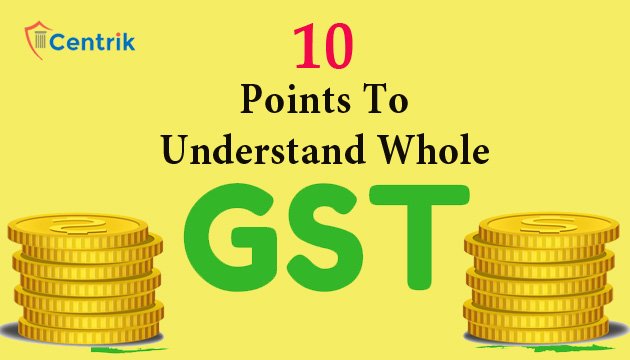
1. Roll out & Applicability
GST is expected to be implemented from 01/07/2017. GST would apply to all goods and services except Alcohol for human consumption. GST on petroleum products shall be levied at later date.GST shall not be applicable to Jammu and Kashmir.
GST would be based on the principle of destination based consumption taxation as against the present principle of origin based taxation.
2. Replaced Laws
GST is to replace following indirect taxes at Centre and State Level.
| Centre |
Central Excise Duly Additional Duty of Excise Additional Duty of Customs (CVD & SAD) Service tax Surcharges & Cesses |
| State |
State VAT/Sales Tax Central Sales Tax Entertainment tax Purchase tax Luxury Tax Entry Tax (All forms) Tax on Lottery, betting & gambling Surcharges & Cesses |
3. Laws under GST
It would be a dual GST with the Centre and the States simultaneously levying it on a common base. Following 5 kind of laws shall be implemented:
| Laws | Purpose |
| CGST Laws | GST by Central Government on all within State Supplies |
| SGST Laws | GST by States on all within State Supplies |
| UTGST | GST by Union Territories (without Legislature) |
| IGST | GST on all Inter- State supplies including import |
| GST Compensation Laws | For compensating the States for any loss of revenue |
4. Registration & returns
GST registration would be PAN based and shall be required if turnover is in excess of Rs. 20 Lacs (Rs. 10 Lacs for Special Category States). Monthly returns and payment shall be made through online mode.
5. Tax rates & Compounding option
Four tax rates namely 5%, 12%, 18% and 28% has been specified. Item-wise rates shall be decided soon by GST council. Besides, some goods and services would be under the list of exempt items.
A cess over the peak rate of 28% on certain specified luxury and sin goods.
A compounding option to specified category of manufacturers and service providers) having an annual turnover of upto Rs. 50 lacs.
6. Input Credit
Credit shall be allowed only if invoice is matched at the time of return filing. The credit would be utilized in the following manner:ITC of CGST allowed for payment of CGST & IGST in that order;
a) ITC of CGST allowed for payment of CGST & IGST in that order;ITC of SGST allowed for payment of SGST & IGST in that order;
b) ITC of SGST allowed for payment of SGST & IGST in that order;
c) ITC of UTGST allowed for payment of UTGST & IGST in that order;
d) ITC of IGST allowed for payment of IGST, CGST & SGST/UTGST in that order.
e) ITC of CGST cannot be used for payment of SGST/UTGST and vice versa.
7. TDS provisions
TDS @ 1% by certain persons including government departments, local authorities and government agencies, where total value of supply, under a contract, exceeds two lakhs and fifty thousand rupees (Rs. 2.5 lac).
8. TCS by E-commerce operators
TCS @ not exceeding 1% by electronic commerce operators of net value of taxable supplies, out of payments to suppliers supplying goods or services through their portals.
9. Period of Raising Demand
Limitation period for raising demand is 3 years in normal cases, and 5 years in case of fraud, suppression or willful mis-statement.
10. Administration and Penal provisions
In order to ensure single interface, all administrative control over 90% of taxpayers having turnover below Rs. 1.5 crore would vest with State tax administration and 10% with the Central tax administration. Further all administrative control over taxpayers having turnover above Rs. 1.5 crore shall be divided equally in the ratio of 50% each for the Central and State tax administration. Heavy penalties and punishment has been provided for violation of laws
For any clarification, please reach me at amarpal@centrik.in




 join For Updates
join For Updates